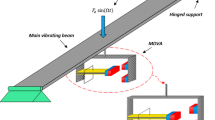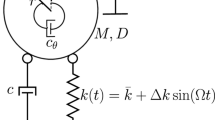Abstract
An algorithm is presented to analyze the free vibration in a system composed of a cable with discrete elements, e.g., a concentrated mass, a translational spring, and a harmonic oscillator. The vibrations in the cable are modeled and analyzed with the Lagrange multiplier formalism. Some fragments of the investigated structure are modeled with continuously distributed parameters, while the other fragments of the structure are modeled with discrete elements. In this case, the linear model of a cable with a small sag serves as a continuous model, while the elements, e.g., a translational spring, a concentrated mass, and a harmonic oscillator, serve as the discrete elements. The method is based on the analytical solutions in relation to the constituent elements, which, when once derived, can be used to formulate the equations describing various complex systems compatible with an actual structure. The numerical analysis shows that, the method proposed in this paper can be successfully used to select the optimal parameters of a system composed of a cable with discrete elements, e.g., to detune the frequency resonance of some structures.
Similar content being viewed by others
References
SERGEV, S. S. and IWAN, W. D. The natural frequencies and mode shapes of cables with attached masses. Journal of Energy Resources Technology, 3, 237–242 (1981)
CHENG, S. P. and PERKINS, N. C. Free vibration of a sagged cable supporting a discrete mass. The Journal of the Acoustical Society of America, 91, 2654–2662 (1992)
LIN, H. P. and PERKINS, N. C. Free vibration of complex cable/mass systems: theory and experiment. Journal of Sound and Vibration, 179, 131–149 (1995)
AL-QASSAB, M. and NAIR, S. Wavelet-Galerkin method for the free vibrations of an elastic cable carrying an attached mass. Journal of Sound and Vibration, 270, 191–206 (2004)
WANG, L. and REGA, G. Modelling and transient planar dynamics of suspended cables with moving mass. International Journal of Solids and Structures, 47, 2733–2744 (2010)
MAIN, J. A. and JONES, N. P. Free vibrations of taut cable with attached damper, I: linear viscous damper. Journal of Engineering Mechanics, 128, 1062–1071 (2002)
CU, V. H., HAN, B., PHAM, D. H., and YAN, W. T. Free vibration and damping of a taut cable with an attached viscous mass damper. KSCE Journal of Civil Engineering, 22, 1792–1802 (2018)
SUN, L. H. and CHEN, L. Free vibrations of a taut cable with a general viscoelastic damper modeled by fractional derivatives. Journal of Sound and Vibration, 335, 19–33 (2015)
ZHOU, H., SUN, L., and XING, F. Damping of full-scale stay cable with viscous damper: experiment and analysis. Advances in Structural Engineering, 17, 265–274 (2014)
ZHOU, H., SUN, L., and XING, F. Free vibration of taut cable with a damper and a spring. Structural Control and Health Monitoring, 21, 996–1014 (2014)
YU, Z. and XU, Y. L. Mitigation of three-dimensional vibration of inclined sag cable using hdiscrete oil dampers, I: formulation. Journal of Sound and Vibration, 214, 659–673 (1998)
WU, W. J. and CAI, C. S. Theoretical exploration of a taut cable and a TMD system. Engineering Structures, 29, 962–972 (2007)
CHEN, L., SUN, L., and NAGARAJAIAH, S. Cable vibration control with both lateral and rotational dampers attached at an intermediate location. Journal of Sound and Vibration, 377, 38–57 (2016)
MEKKI, O. B. and AURICCHIO, F. Performance evaluation of shape-memory-alloy superelastic behavior to control a stay cable in cable-stayed bridges. International Journal of Non-Linear Mechanics, 46, 470–477 (2011)
ZHOU, H., YANG, X., SUN, L., and XING, F. Free vibrations of a two-cable network with near-support dampers and a cross-link. Structural Control and Health Monitoring, 22, 1173–1192 (2015)
GIACCU, G. F., CARACOGILA, L., and BARBIELLINI, B. Modeling unilateral response in the cross-ties of a cable network: deterministic vibration. Journal of Sound and Vibration, 333, 4427–4443 (2014)
GIACCU, G. F. and CARACOGILA, L. Effects of modeling nonlinearity in cross-ties on the dynamics of simplified in-plane cable networks. Structural Control and Health Monitoring, 19, 348–369 (2012)
AHMAD, J., CHENG, S., and GHRIB, F. Impact of cross-tie properties on the modal behavior of cable networks on cable-stayed bridges. Scientific World Journal, 2015, 989536 (2015)
YAMAGUCHI, H. and ALAUDDIN, M. Control of cable vibrations using secondary cable with special reference to nonlinearity and interaction. Engineering Structures, 25, 801–816 (2003)
DOWELL, E. H. Free vibrations of a linear structure with arbitrary support conditions. Journal of Applied Mechanics, 38, 595–600 (1971)
DOWELL, E. H. Free vibrations of an arbitrary structure in terms of component modes. Journal of Applied Mechanics, 39, 727–732 (1972)
DOWELL, E. H. On some general properties of combined dynamical systems. Journal of Applied Mechanics, 46, 206–209 (1979)
GÜRGÖZE, M. On the eigenfrequencies of a cantilever beam with attached tip mass and a spring-mass system. Journal of Sound and Vibration, 190, 149–162 (1996)
GÜRGÖZE, M. On the alternative formulations of the frequency equation of a Bernoulli-Euler beam to which several spring-mass systems are attached in-span. Journal of Sound and Vibration, 217, 585–595 (1998)
GÜRGÖZE, M. Mechanical systems with a single viscous damper subject to a constraint equation. Computers and Structures, 70, 299–303 (1999)
GÜRGÖZE, M. and Erol, H. On the eigencharacteristics of longitudinally vibrating rods carrying a tip mass and viscously damped spring-mass in-span. Journal of Sound and Vibration, 225, 573–580 (1999)
POSIADAŁA, B. Use of Lagrange multiplier formalism to analyze free vibrations of combined dynamical systems. Journal of Sound and Vibration, 176, 563–572 (1994)
POSIADAŁA, B. Free vibrations of uniform Timoshenko beams with attachments. Journal of Sound and Vibration, 204, 359–369 (1997)
POSIADAŁA, B. and CEKUS, D. Discrete model of vibration of truck crane telescopic boom with consideration of the hydraulic cylinder of crane radius change in the rotary plane. Automation in Construction, 17, 245–250 (2008)
POSIADAŁA, B., CEKUS, D., and WARYS, P. Algorithm for automatic analysis of free vibrations of uniform Bernoulli-Euler beams with attachments. Proceedings of the World Congress on Engineering and Computer Science 2012, San Francisco (2012)
CEKUS, D. Use of Lagrange multiplier formalism to solve transverse vibrations problem of stepped beams according to Timoshenko theory. Scientific Research of the Institute of Mathematics and Computer Science, 10, 49–56 (2011)
KUKLA, S. and POSIADAŁA, B. Free vibrations of beams with elastically mounted masses. Journal of Sound and Vibration, 175, 557–564 (1994)
KUKLA, S. Application of Green functions in frequency analysis of Timoshenko beams with oscillators. Journal of Sound and Vibration, 205, 355–363 (1997)
CHA, P. D. Eigenvalues of a linear elastic a carrying lumped masses, springs and viscous dampers. Journal of Sound and Vibration, 257, 798–808 (2002)
CHA, P. D. and PIERRE, C. Free vibrations of uniform Timoshenko beams with lumped attachments. Journal of Sound and Vibration, 211, 273–176 (1998)
CHA, P. D. Specifying nodes at multiple locations for any normal mode of a linear elastic structure. Journal of Sound and Vibration, 250, 923–934 (2002)
IRVINE, H. M. and CAUGHEY, T. K. The linear theory of free vibrations of a suspended cable. Proceedings of The Royal Society A, 341, 299–315 (1974)
IRVINE, H. M. Cable Structures, The MIT Press, Cambridge (1981)
CAETANO, E. Cable Vibration in Cable-Stayed Bridges, IABSE-AIPC-IVBH ETH Hönggerberg, Zürich (2007)
Author information
Authors and Affiliations
Corresponding author
Additional information
Citation: PAKOS, W. Free vibration of a sagged cable with attached discrete elements. Applied Mathematics and Mechanics (English Edition) (2019) https://doi.org/10.1007/s10483-019-2479-6
Rights and permissions
About this article
Cite this article
Pakos, W. Free vibration of a sagged cable with attached discrete elements. Appl. Math. Mech.-Engl. Ed. 40, 631–648 (2019). https://doi.org/10.1007/s10483-019-2479-6
Received:
Revised:
Published:
Issue Date:
DOI: https://doi.org/10.1007/s10483-019-2479-6




